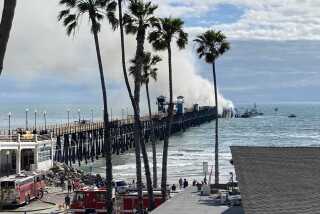Too Much Perchlorate in Milk, Report Says
Milk sold in Southern California supermarkets contains a toxic ingredient of rocket fuel that exposes many children to amounts exceeding a federal health recommendation, according to a report by an environmental organization released Monday.
Out of 33 samples of well-known brands of milk purchased in Los Angeles and Orange counties, the Environmental Working Group found the chemical perchlorate in all but one. Children from 1 to 5 years old who drink between one and two cups of milk a day are getting daily amounts higher than the U.S. Environmental Protection Agency recommends.
Perchlorate, the explosive component of rocket fuel, has leaked from aerospace companies and military bases and contaminated water supplies in 29 states, including the lower Colorado River, which supplies much of Southern California’s drinking water and irrigates over a million acres of farmland in California and Arizona. Infants and fetuses are especially vulnerable to the effects of perchlorate. Animal tests indicate that small amounts can disrupt thyroid hormones that regulate brain development.
“Our findings are not a call for California mothers to stop drinking milk or stop giving it to their children,” said Bill Walker, vice president of Environmental Working Group. “They do show that the state must set a drinking water standard that fully protects public health. Mothers should not be forced to wonder if milk is affecting their child’s growth and development.”
Michael Payne, a veterinary toxicologist at UC Davis, said based on the scientific knowledge today, there is no need for parents to change their children’s diets. He especially worries because milk is one of the most nutritious foods that children consume, providing calcium, protein and minerals.
In large amounts, perchlorate can alter thyroid hormones, he said. But in small amounts, like those in milk, no human studies have found any adverse effect related to perchlorate, and two studies have found no effects on children or newborns.
Perchlorate has been the focus of a nationwide controversy because no federal or state regulations limit the amount allowed in drinking water. California is preparing to set a standard early next year.
The study confirms that in California the rocket fuel chemical is also present in foods. Perchlorate was found in lettuce in tests last year.
Half of children under age 5 and a third of children between 6 and 11 drink enough milk to exceed the EPA’s recommended maximum daily allowance of 1 part per billion of perchlorate, according to the group’s calculations. California’s recommended allowance is 6 ppb daily. The average amount in Southern California milk was 1.3 ppb.
Children between 1 and 2 years old drink an average of about two cups of milk a day, based on U.S. Department of Agriculture data. That means that the average 1-year-old in Southern California would get twice the EPA’s recommended daily allowance.
Because California children are ingesting perchlorate in food and drinking water, it is likely that nearly all of them are exceeding the recommendation, the Environmental Working Group reported. Cheese, yogurt and other dairy products are likely to be as contaminated as milk.
Because the state and federal recommended allowances, based on amounts that harmed animals in lab tests, are not enforceable standards, water suppliers do not have to meet them.
There are also no federal or state standards for perchlorate in milk or other food.
The Bush administration postponed setting a federal limit for perchlorate after defense contractors and the Pentagon lobbied for a delay to await results of a National Academy of Sciences review, due this fall. Cleaning up the contaminant would be a huge job, costing perhaps billions of dollars.
The California dairy industry said Monday that there is insufficient knowledge about perchlorate to determine how much is safe in the water and food supply. Kevin Abernathy, executive director of the California Dairy Campaign, said the industry “would like to see more scientific research done to actually come up with numbers to protect public health.
Until that time, it’s pretty difficult to determine” what poses a threat.
Abernathy said the dairy industry is “living with someone else’s poor environmental stewardship,” because the pollution that contaminates the cows comes from other industries, mostly aerospace. California is the nation’s leading dairy producer, with nearly $5 billion in annual sales and 1.7 million milk cows.
In Southern California, the highest perchlorate concentrations were found in whole and 2% milk purchased at a Los Angeles store.
The group did not release brand names or store locations. Milk sampled in Orange County contained lower levels than milk in Los Angeles County.
Similar tests, conducted by the state in April, showed that milk tested in silos around the state contains almost five times more perchlorate than milk sold in Los Angeles and Orange counties. The state Department of Food and Agriculture found perchlorate in all 32 samples of milk, at an average amount of nearly 6 ppb.
The reasons for the wide variation are unknown. The amount of perchlorate in milk apparently depends on where the dairy cows are raised, because irrigation water used on alfalfa is the most likely source.
The amount of perchlorate in milk is equivalent to “diluting a sugar cube in an oil tanker,” Payne of UC Davis said.
Though tiny recurring amounts of some contaminants, such as mercury and polychlorinated biphenyls, or PCBs, can harm children and fetuses, the evidence for perchlorate is inadequate, he said. “The risk is theoretical at this point.”
Fetuses are the most vulnerable to chemicals that alter thyroid hormones. About 7% of women of childbearing age drink enough milk to get daily amounts of perchlorate that exceed the EPA’s recommended level, according to the tests.
More to Read
Start your day right
Sign up for Essential California for news, features and recommendations from the L.A. Times and beyond in your inbox six days a week.
You may occasionally receive promotional content from the Los Angeles Times.






